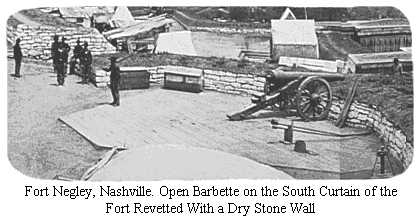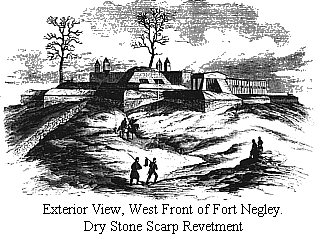Dry Stone revetments were not described by an any
period engineering manuals, some of which went to the trouble to point out
that masonry revetments were wholly unsuitable for temporary field works.
But, engineers had to work with what they had, and they had plenty of rocks
at Nashville, Tennessee and didn't have to dig more than two or three down
to find more if they ran short. Some of the forts in the city's defenses
had to have their ditches blasted out of bedrock, which produced a surfeit
of raw material for stone walls. This raw material was put to good use to
construct revetments for just about any slope that needed the treatment.
 Fort Negley, the largest of the
forts in Nashville's defenses and one of the most peculiar semi-permanent
fortifications designed and actually constructed during the war, enjoyed
a superabundance of dry stone revetments. Dry stone gets its name from the
fact that stones used to construct such a wall were worked to fit in place
in the wall and were laid on without benefit of intervening fixative
substances. That is, dry stone walls were constructed without any mortar
to fill gaps and hold the stones in place. Their stability depends on mass
and balance; balance on depends on a good load distribution and a tight fit
between stones. Getting a good fit means selecting and working each stone
individually and preferably getting the work done by experienced stone masons
who understand how such a wall should be pieced together. In other words,
creating a sound dry stone revetment required an abundance of material, a
specialized labor force, and a great deal more time than could possibly be
allowed for the construction of a temporary field work. This helps explain
the fact that the defenses of Nashville, which were somewhat less than
extensive, were a project perpetually in progress. Fort Negley, the largest of the
forts in Nashville's defenses and one of the most peculiar semi-permanent
fortifications designed and actually constructed during the war, enjoyed
a superabundance of dry stone revetments. Dry stone gets its name from the
fact that stones used to construct such a wall were worked to fit in place
in the wall and were laid on without benefit of intervening fixative
substances. That is, dry stone walls were constructed without any mortar
to fill gaps and hold the stones in place. Their stability depends on mass
and balance; balance on depends on a good load distribution and a tight fit
between stones. Getting a good fit means selecting and working each stone
individually and preferably getting the work done by experienced stone masons
who understand how such a wall should be pieced together. In other words,
creating a sound dry stone revetment required an abundance of material, a
specialized labor force, and a great deal more time than could possibly be
allowed for the construction of a temporary field work. This helps explain
the fact that the defenses of Nashville, which were somewhat less than
extensive, were a project perpetually in progress.

[This page originally appeared as a Detailed Notes Page on
the old Civil War Field Fortifications Website.] |